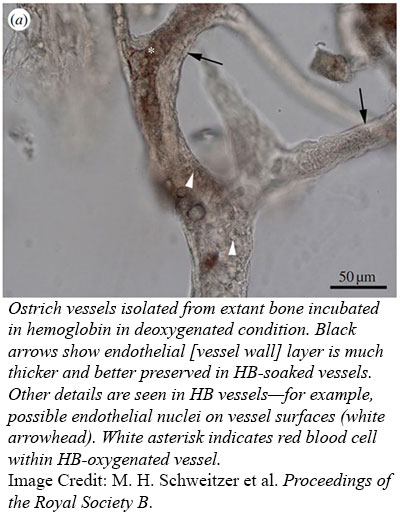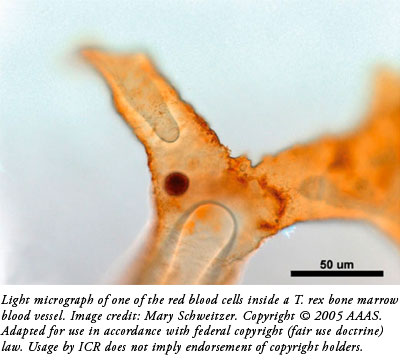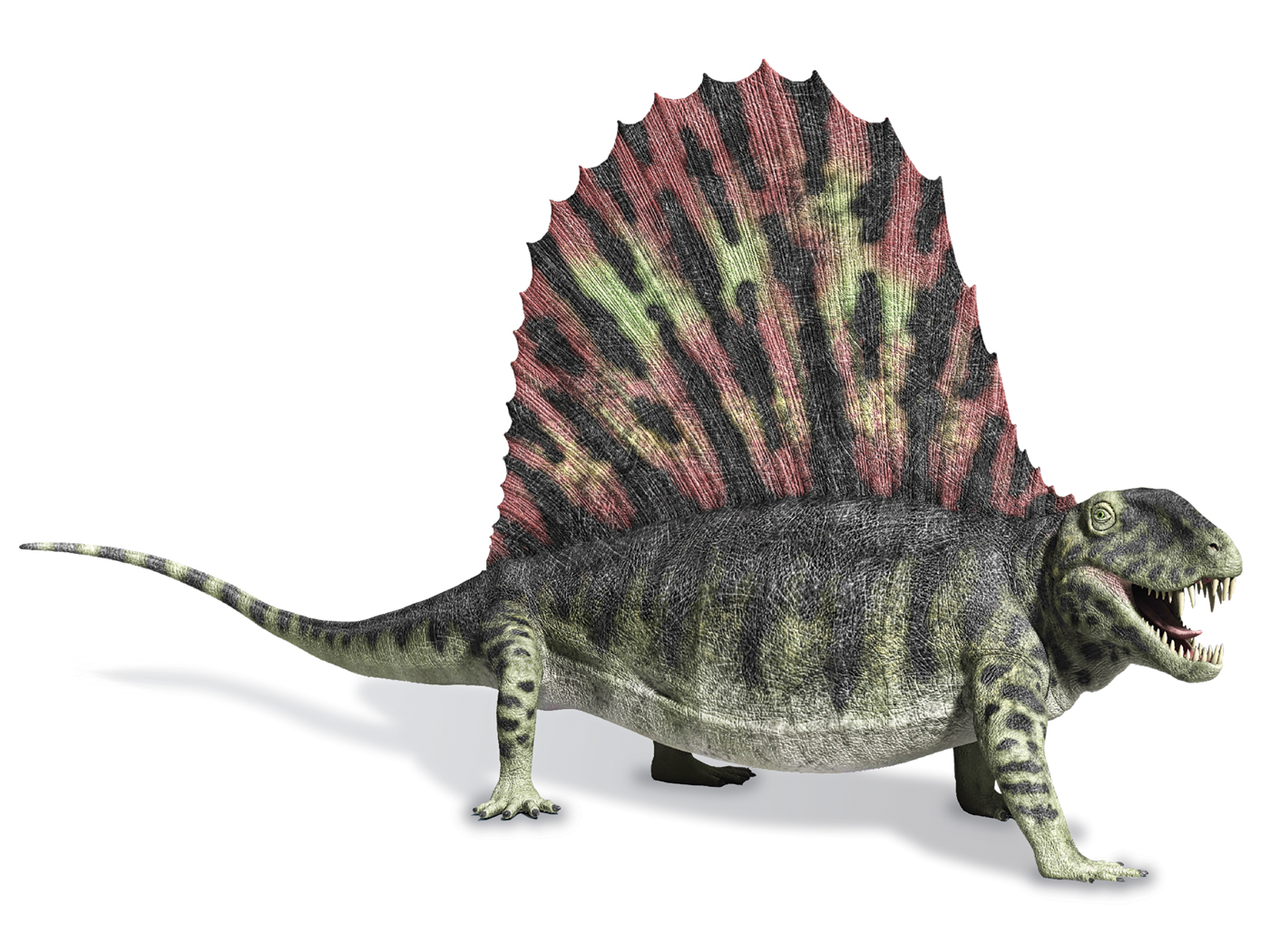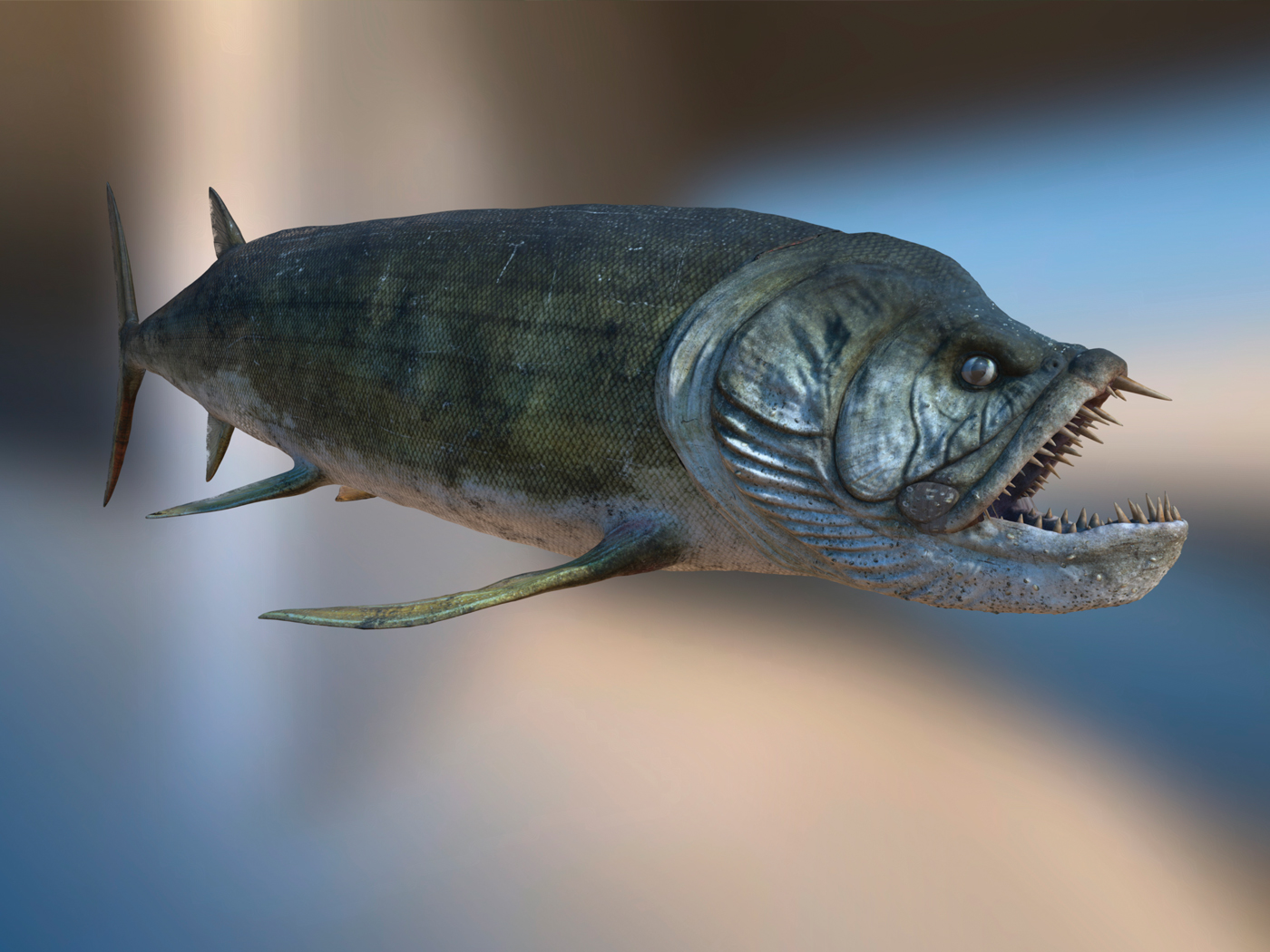Researchers are now suggesting that iron embedded in blood proteins preserved the still-soft tissues, cells, and molecules discovered inside dinosaurs and other fossils after the creatures were buried in sediments. The ability to justify millions of years is at stake, and this study promises to do just that. What are its merits and demerits?
Publishing in the journal Proceedings of the Royal Society B, Mary Schweitzer led a team that showed how iron atoms from blood adhere to and preserve blood vessels.1 The team placed ostrich bone blood vessels in water and watched them disintegrate in less than a week. They then treated another set of ostrich blood vessels with concentrated blood, and the treated blood vessels still looked fresh after two years of sitting on the lab bench.
They postulated that iron generates chemically reactive oxy radicals that help adjacent proteins bond, preserving their overall structure in a process called cross-linking. The way a fried egg resists rotting longer than a raw, cracked egg might illustrate this effect.
“Oxy radicals also facilitate protein cross-linking in a manner analogous to the actions of tissue fixatives (e.g. formaldehyde), thus increasing resistance of these ‘fixed’ biomolecules to enzymatic or microbial digestion,” according to Schweitzer and her colleagues.1
These results are unique and compelling. But do they really justify the study authors’ claim that this iron preservation phenomenon explains how dinosaur tissues lasted for tens of millions of years?
The study authors wrote, “The HB [hemoglobin]–oxygen interactions investigated here explain both the association of iron with many exceptionally preserved fossils and the enhanced preservation of tissues, cells and molecules over deep time.”1
For an experiment to really explain an effect lasting for millions of years, shouldn’t it gather enough time-related measurements to estimate the maximum time that iron-treated soft tissues could last? Only then could researchers directly compare that maximum time with fossils’ evolutionary ages. Schweitzer’s report did not show these kinds of results.
 The scientific community has long shown its desperation to defend mainstream fossil ages against the short shelf-life of soft-tissue fossils. Will they now call upon blood iron to have preserved fossils in a way that these results don’t justify?
The scientific community has long shown its desperation to defend mainstream fossil ages against the short shelf-life of soft-tissue fossils. Will they now call upon blood iron to have preserved fossils in a way that these results don’t justify?
Iron does appear to preserve tissues, even keeping blood vessels intact at room temperature for two years. Could iron keep soft tissues intact for millions of years? At least four reasons show why the study’s results, amazing though they are, answer with a clear “No.”
First, “Ostrich vessels were incubated in a concentrated solution of red blood cell lysate,” according to the study authors.1 Their procedure involved extracting and purifying iron from blood. But ancient dinosaur and other fossils did not have the advantage of scientists treating their carcasses with a blood-soup concentrate.
Second, many of the still-fresh fossil biochemicals described in the literature do not show evidence of nearby iron. For example, researchers have encountered bone cells called osteocytes locked inside dinosaur bones, including a Triceratops horn core.2 These cells have fine, threadlike extensions that penetrate the bone’s mineral matrix through tiny tunnels called canaliculi. Could concentrated blood penetrate and preserve those almost inaccessible bone cells?
Schweitzer and her coauthors think so. They wrote, “In life, blood cells rich in iron-containing HB [hemoglobin] flow through vessels, and have access to bone osteocytes through the lacuna-canalicular network.”1 Yet, the study authors did not demonstrate this supposed access, they merely asserted it.
For example, have experiments shown that canaliculi can wick blood puree, despite having tiny diameters on the order of 0.0004 millimeters? Also, how could iron-rich preservative “have access to” tiny tunnels already clogged with osteocytes? Other examples of original soft tissues without these iron particles include mummified dinosaur and lizard skin.3,4
Third, for experimental control, the Royal Society authors kept ostrich vessels in water to watch them rot.1 Does this resemble the burial conditions of dinosaurs, which are mostly dry today and have been primarily dry perhaps since the day of burial? Water accelerates tissue decay by providing for microbes and by facilitating degradative chemistry. So by adding water, these scientists may have rigged their “control” sample to show a higher-than-expected decay rate difference.
 The researchers then compared their hemoglobin-soaked samples to the watered-down samples and wrote, “In our test model, incubation in HB increased ostrich vessel stability more than 240-fold, or more than 24000% over control conditions.”1 If both their control and test models used unrealistic conditions, then they dulled the edge of their entire argument.
The researchers then compared their hemoglobin-soaked samples to the watered-down samples and wrote, “In our test model, incubation in HB increased ostrich vessel stability more than 240-fold, or more than 24000% over control conditions.”1 If both their control and test models used unrealistic conditions, then they dulled the edge of their entire argument.
Fourth, just because this iron increases the “resistance of these ‘fixed’ biomolecules to enzymatic or microbial digestion” does not necessarily mean that it increases resistance of these “fixed” biomolecules to degrading chemical reactions.1 In other words, these authors have again shown that iron inhibits microbes, but they did not show that it inhibits the oxidation and hydrolysis reactions known to relentlessly convert tissues into dust.
Plus, though they showed how iron ups resistance to microbes for two years, they did not show that it does so for millions of years. Getting these tissues to resist enzymes and microbes is the lowest hurdle. These results fail to demonstrate the next step—getting tissues to resist the laws of chemistry for unimaginable time spans.
While the study does show that iron helps preserve soft tissues, the results fall far short of the authors’ claim that this explains soft tissue persisting for millions of years. Concentrated blood and extra water may not approximate real conditions, iron is not always present with known original tissue fossils, and the scientists did not produce a useful time-to-dust estimate for their iron-encrusted tissues.
By showing that iron particles stuck to dinosaur blood vessels look similar to those attached to ostrich vessels, this research may explain how soft tissues have resisted disintegration for longer-than-expected intervals—for example, thousands of years.
References
- Schweitzer, M. H. et al. A role for iron and oxygen chemistry in preserving soft tissues, cells and molecules from deep time. Proceedings of the Royal Society B. Published online before print, November 27, 2013.
- Armitage, M. H. and K. L. Anderson. 2013. Soft sheets of fibrillar bone from a fossil of the supraorbital horn of the dinosaur Triceratops horridus. Acta Histochemica.115 (6): 603-608.
- Lingham-Soliar, T. and G. Plodowski. 2010. The integument of Psittacosaurusfrom Liaoning Province, China: taphonomy, epidermal patterns and color of a ceratopsian dinosaur. Naturwissenschaften. 97 (5): 479-486.
- Edwards, N. P. et al. 2011. Infrared mapping resolves soft tissue preservation in 50 million year-old reptile skin. Proceedings of the Royal Society B. 278 (1722): 3209-3218.
* Mr. Thomas is Science Writer at the Institute for Creation Research.
Article posted on December 11, 2013.
















